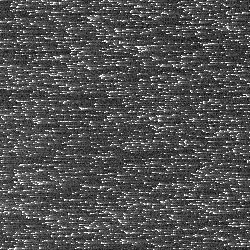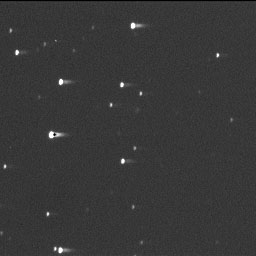CTE is an acronym for Charge Transfer Efficiency. As the charge is moved from pixel to pixel across the CCD it is inevitable that a few electrons will be left behind. If this number of electrons is too large smearing will occur. CTE is usually expressed as an number near one, with 1 being perfect efficiency. A typical CTE of a properly operating CCD is 0.99999, meaning that of every 100,000 electrons, one will be left behind.
CTE can be measured in both the serial (horizontal) and parallel (vertical) direction. Problems with CTE can occur in either direction, but are more common in the serial direction due to the higher speed of the serial register.
To quickly check CTE simply take a dark frame and note the appearance of the hot pixels. The hot pixels should be perfect points in the image (see the ideal dark frames on the main page) It will be necessary to stretch the image dramatically to see any effect. Both images below show serious CTE problems in the serial direction. Click on either image to download 16bit TIFF that you can load into your processing software to examine for yourself. One image shows a low level serial CTE issue while the other image shows a high level CTE issue.
Serial CTE issues are usually the result of an adjustment or design problem in the camera. Return the camera to the manufacturer for service.

Image courtesy Dean Salman
